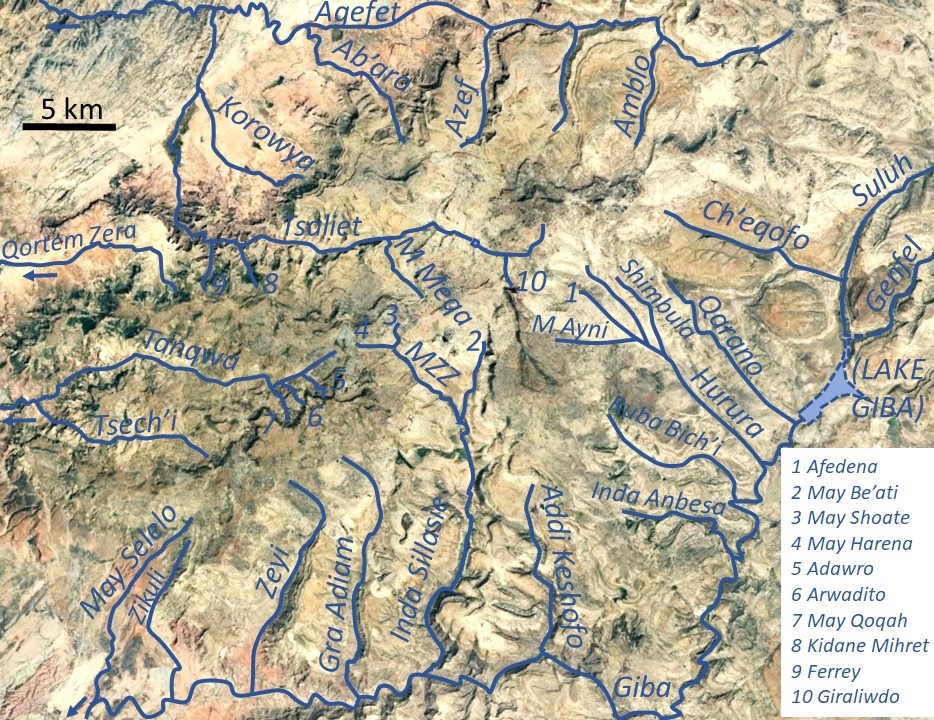Agefet on:
[Wikipedia]
[Google]
[Amazon]
The Agefet is a river of the 
 The Agefet is a confined ephemeral river, locally
The Agefet is a confined ephemeral river, locally
Nile
The Nile (also known as the Nile River or River Nile) is a major north-flowing river in northeastern Africa. It flows into the Mediterranean Sea. The Nile is the longest river in Africa. It has historically been considered the List of river sy ...
basin. Rising in the mountains of Gheralta in northern Ethiopia
Ethiopia, officially the Federal Democratic Republic of Ethiopia, is a landlocked country located in the Horn of Africa region of East Africa. It shares borders with Eritrea to the north, Djibouti to the northeast, Somalia to the east, Ken ...
, it flows westward to empty finally in the Weri’i which itself discharges into Tekezé River
The Tekezé River (; , originally meaning "river" in Ge’ez; , also spelled Takkaze; ), is a major river in Ethiopia. For part of its course it forms a section of the westernmost border of Ethiopia and Eritrea. The river is also known as the Seti ...
.

Characteristics
 The Agefet is a confined ephemeral river, locally
The Agefet is a confined ephemeral river, locally meander
A meander is one of a series of regular sinuous curves in the Channel (geography), channel of a river or other watercourse. It is produced as a watercourse erosion, erodes the sediments of an outer, concave bank (cut bank, cut bank or river cl ...
ing in its narrow alluvial plain, with an average slope gradient of 13 metres per kilometre. At the end of its course, it occupies a sandy pediment.
Flash floods and flood buffering
Runoff mostly happens in the form of high runoff discharge events that occur in a very short period (called flash floods). These are related to the steep topography, often little vegetation cover and intense convective rainfall. The peaks of such flash floods have often a 50 to 100 times larger discharge than the precedingbaseflow
Baseflow (also called drought flow, groundwater recession flow, low flow, low-water flow, low-water discharge and sustained or fair-weather runoff) is the portion of the streamflow that is sustained between precipitation events, fed to streams by d ...
.
The magnitude of floods in this river has however been decreased due to interventions in the catchment. Physical conservation structures such as stone bunds and check dams intercept runoff. On many steep slopes, exclosures have been established; the dense vegetation largely contributes to enhanced infiltration, less flooding, and better baseflow
Baseflow (also called drought flow, groundwater recession flow, low flow, low-water flow, low-water discharge and sustained or fair-weather runoff) is the portion of the streamflow that is sustained between precipitation events, fed to streams by d ...
.
Transhumance towards the gorge
Transhumance
Transhumance is a type of pastoralism or Nomad, nomadism, a seasonal movement of livestock between fixed summer and winter pastures. In montane regions (''vertical transhumance''), it implies movement between higher pastures in summer and low ...
takes place in the summer rainy season, when the lands near the villages are occupied by crops. Young shepherds will take the village cattle down to the Agefet gorge. The gorges are particularly attractive as a transhumance destination zone, because there is water and good growth of semi-natural vegetation.
Boulders and pebbles in the river bed
From upstream to downstream, the following lithological units occur in the catchment. *Phonolite
Phonolite is an uncommon shallow intrusive or extrusive rock, of intermediate chemical composition between felsic and mafic, with texture ranging from aphanitic (fine-grained) to porphyritic (mixed fine- and coarse-grained). Phonolite is a var ...
plugs
* Upper basalt
* Interbedded lacustrine deposits
* Lower basalt
* Amba Aradam Formation
* Antalo Limestone
* Quaternary
The Quaternary ( ) is the current and most recent of the three periods of the Cenozoic Era in the geologic time scale of the International Commission on Stratigraphy (ICS), as well as the current and most recent of the twelve periods of the ...
freshwater tufa
Tufa is a variety of limestone formed when carbonate minerals precipitation (chemistry), precipitate out of water in ambient temperature, unheated rivers or lakes. hot spring, Geothermally heated hot springs sometimes produce similar (but less ...
* Adigrat Sandstone
* Edaga Arbi Glacials
Logically, in the uppermost stretches of the river, only the pebbles and boulders of the upper lithological units will be present in the river bed, whereas more downstream one may find a more comprehensive mix of all lithologies crossed by the river.
Natural boundary
During its course, this river passes through three woredas ( Kola Tembien, Dogu’a Tembien and Kilte Awula’ilo) and constitutes the border between the two latter over a dozen of kilometres.Trekking along the river
Trekking routes have been established across and along this river. The tracks are not marked on the ground but can be followed using downloaded .GPX files. * Trek Gh1, follows the river in its eastern course * Trek Gh2, crosses the river in its western course In the rainy season, flash floods may occur, and it is advised not to follow the river bed. Generally, it is impossible to cross the river in the rainy season.See also
* List of Ethiopian riversReferences
{{reflist Rivers of Ethiopia Dogu'a Tembien Tigray Region Nile basin